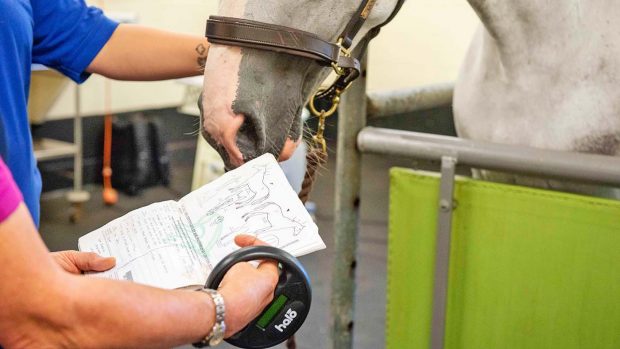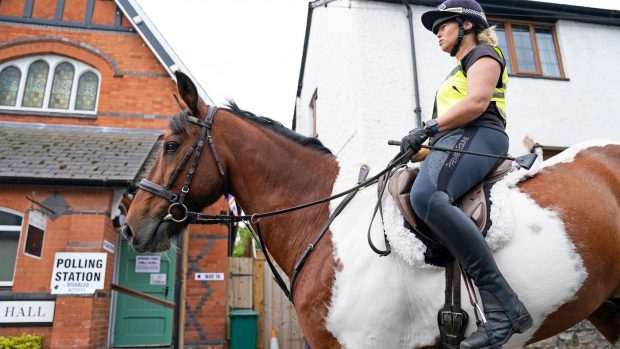Traditionally, we have used a description of colour and markings, such as white legs and whorls, to identify an individual horse. Freeze-branding is also effective for most horses, especially as it is readily visible. But brands can be tampered with or disguised and may become less distinct over time.
Officially, passports will be mandatory after February 2005 and will provide a method to both age and identify a horse. However, with approximately 70 separate passport-issuing authorities, and the proposed central co-ordinating body is not yet functioning, the system appears open to abuse with limited controls to prevent a horse having more than one identity.
Many horse vets advocate microchips as the best means to identify an individual horse, and their use is increasing. A tiny microchip (about the size of a grain of rice) is implanted in the nuchal ligament on the left side of the horse’s neck. It is a surgical procedure, so has some potential for complications, but these are rare. Instead, the most commonly encountered problem is how to insert the relatively large needle containing the microchip safely into an animal that does not want to be injected.
The theory of microchips is great: every horse has an individual number somewhat like a car number plate, which can be viewed using a reader. This number can then be linked to a computerised database where information on ownership and other details can be stored. For the system to work, the data needs to be recorded properly and kept up to date.
This electronic form of identification has several advantages over more traditional approaches, including:
- If the horse is separated from its identity document, it should still be identifiable
- The implant has a individual number that is linked to a database, which can be checked out, for instance, in a case of theft
- This method of identification is tamper-proof
A snag with microchips is that they cannot be detected without the appropriate scanner or microchip reader. Not only is the right piece of kit required, but it needs to be the correct sort for that type of microchip otherwise it will remain undetected. Ultimately the microchips work, we just need to be able to see them and have the correct records to identify the horse from the microchip when it is read.
Many anecdotal tales exist of microchips being present that do not match the horse in question. Another potential, but unlikely, concern is that the microchips may migrate away from the site of implant and for this reason anyone using a reader will check right around the neck if a microchip is not in the usual place. Fortunately, microchips can also show up on an X-ray picture.
Microchips are the same as any other modern technology; the information is only as good as the operator and their equipment. The information needs to be able to be read and recorded properly worldwide. To this end, the International Organisation of Standards (ISO) has published an agreed standard for the electronic component of microchips, so the situation should now be improving for global identification.
The Thoroughbred industry — along with some other breed societies — has been using blood typing for some time. Blood typing has served the industry well, not so much as a way of identifying the individual horse, but more for parentage testing. This can be crucial for horse breed registries, where there is a need to know that a foal is indeed bred as reported. Once there is a sample on file, a comparison can be made to confirm that the horse’s identity is correct in future.
Blood typing is based on testing proteins, and recent innovations have enabled laboratories to go back a stage and test the DNA, which is the individual’s genetic code material. DNA testing has a number of advantages over blood typing, including:
- DNA can be obtained from almost any body tissue. The easiest tissue to collect from a horse has to be a hair sample, which must have the follicle or root attached. This is regularly required by Weatherbys and other UK authorities, who ask the vet to pluck a number of tail hairs. This is significantly simpler than collecting a blood sample in the majority of horses. Once collected, you cannot spill or spoil hairs as can happen to a vial of blood
- For the standard test of 12 DNA systems commonly used, the probability of detecting an incorrect parentage is 99.99%; hence it will be as effective in identifying an individual horse
- The lab tests used for DNA are simpler than for blood, so are less costly
DNA analysis may be the way forward for the future. Your horse’s passport application may require a few hairs being sent in rather than an identification diagram. Apparently, various authorities are investigating this method, which is already being utilised by several breed societies.
|
||
 |
||


 Get up to 19 issues FREE
Get up to 19 issues FREE TO SUBSCRIBE
TO SUBSCRIBE 



